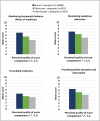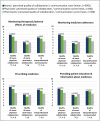EUPRON: nurses' practice in interprofessional pharmaceutical care in Europe. A cross-sectional survey in 17 countries
- PMID: 32499269
- PMCID: PMC7282395
- DOI: 10.1136/bmjopen-2019-036269
EUPRON: nurses' practice in interprofessional pharmaceutical care in Europe. A cross-sectional survey in 17 countries
Abstract
Objectives: Safe pharmaceutical care (PC) requires an interprofessional team approach, involving physicians, nurses and pharmacists. Nurses' roles however, are not always explicit and clear, complicating interprofessional collaboration. The aim of this study is to describe nurses' practice and interprofessional collaboration in PC, from the viewpoint of nurses, physicians and pharmacists.
Design: A cross-sectional survey.
Setting: The study was conducted in 17 European countries, each with their own health systems.
Participants: Pharmacists, physicians and nurses with an active role in PC were surveyed.
Main outcome measures: Nurses' involvement in PC, experiences of interprofessional collaboration and communication and views on nurses' competences.
Results: A total of 4888 nurses, 974 physicians and 857 pharmacists from 17 European countries responded. Providing patient education and information (PEI), monitoring medicines adherence (MMA), monitoring adverse/therapeutic effects (ME) and prescribing medicines were considered integral to nursing practice by 78%, 73%, 69% and 15% of nurses, respectively. Most respondents were convinced that quality of PC would be improved by increasing nurses' involvement in ME (95%), MMA (95%), PEI (91%) and prescribing (53%). Mean scores for the reported quality of collaboration between nurses and physicians, collaboration between nurses and pharmacists and interprofessional communication were respectively <7/10, ≤4/10, <6/10 for all four aspects of PC.
Conclusions: ME, MMA, PEI and prescribing are part of nurses' activities, and most healthcare professionals felt their involvement should be extended. Collaboration between nurses and physicians on PC is limited and between nurses and pharmacists even more.
Keywords: health services administration & management; international health services; quality in healthcare.
© Author(s) (or their employer(s)) 2020. Re-use permitted under CC BY-NC. No commercial re-use. See rights and permissions. Published by BMJ.
Conflict of interest statement
Competing interests: None declared.
Figures



Similar articles
-
Did we do everything we could have? Nurses' contributions to medicines optimization: A mixed-methods study.Nurs Open. 2021 Mar;8(2):592-606. doi: 10.1002/nop2.664. Epub 2020 Oct 24. Nurs Open. 2021. PMID: 33570308 Free PMC article.
-
Perspectives of nurses' role in interprofessional pharmaceutical care across 14 European countries: A qualitative study in pharmacists, physicians and nurses.PLoS One. 2021 May 27;16(5):e0251982. doi: 10.1371/journal.pone.0251982. eCollection 2021. PLoS One. 2021. PMID: 34043650 Free PMC article.
-
The NUPHAC-EU Framework for Nurses' Role in Interprofessional Pharmaceutical Care: Cross-Sectional Evaluation in Europe.Int J Environ Res Public Health. 2021 Jul 25;18(15):7862. doi: 10.3390/ijerph18157862. Int J Environ Res Public Health. 2021. PMID: 34360162 Free PMC article.
-
Developing a competence framework for nurses in pharmaceutical care: A Delphi study.Nurse Educ Today. 2021 Sep;104:104926. doi: 10.1016/j.nedt.2021.104926. Epub 2021 Apr 24. Nurse Educ Today. 2021. PMID: 34274774 Review.
-
Pharmacist-nurse collaborations in medication adherence-enhancing interventions: A review.Patient Educ Couns. 2018 Jul;101(7):1175-1192. doi: 10.1016/j.pec.2018.01.022. Epub 2018 Feb 9. Patient Educ Couns. 2018. PMID: 29628282 Review.
Cited by
-
Nobody ever questions-Polypharmacy in care homes: A mixed methods evaluation of a multidisciplinary medicines optimisation initiative.PLoS One. 2021 Jan 7;16(1):e0244519. doi: 10.1371/journal.pone.0244519. eCollection 2021. PLoS One. 2021. PMID: 33411824 Free PMC article.
-
Home care nurses' management of high-risk medications: a cross-sectional study.J Pharm Policy Pract. 2022 Nov 21;15(1):88. doi: 10.1186/s40545-022-00476-2. J Pharm Policy Pract. 2022. PMID: 36414977 Free PMC article.
-
Clinical Impact of Implementing a Nurse-Led Adverse Drug Reaction Profile in Older Adults Prescribed Multiple Medicines in UK Primary Care: A Study Protocol for a Cluster-Randomised Controlled Trial.Pharmacy (Basel). 2022 Apr 28;10(3):52. doi: 10.3390/pharmacy10030052. Pharmacy (Basel). 2022. PMID: 35645331 Free PMC article.
-
Nurses and Pharmaceutical Care: Interprofessional, Evidence-Based Working to Improve Patient Care and Outcomes.Int J Environ Res Public Health. 2021 Jun 2;18(11):5973. doi: 10.3390/ijerph18115973. Int J Environ Res Public Health. 2021. PMID: 34199519 Free PMC article. Review.
-
Did we do everything we could have? Nurses' contributions to medicines optimization: A mixed-methods study.Nurs Open. 2021 Mar;8(2):592-606. doi: 10.1002/nop2.664. Epub 2020 Oct 24. Nurs Open. 2021. PMID: 33570308 Free PMC article.
References
-
- Cipolle RJ, Strand LM, Morley PC. Pharmaceutical care practice: the patient-centered approach to medication management. 3 edn McGraw-Hill Education, 2012.
-
- Kijlstra N, Ridge K, Walser S. Pharmaceutical care: where do we stand - where should we go? Key concepts in pharmaceutical care, quality assessment of pharmaceutical care in Europe, sources of information: survey report. Strasbourg: European Directorate for the Quality of Medicines & HealthCare (EDQM), 2009.
-
- Keitel S. Pharmaceutical care – policies and practices for a safer, more responsible and cost-effective health system. Strasbourg: European Directorate for the Quality of Medicines & HealthCare (EDQM), 2012.
Publication types
MeSH terms
LinkOut - more resources
Full Text Sources
